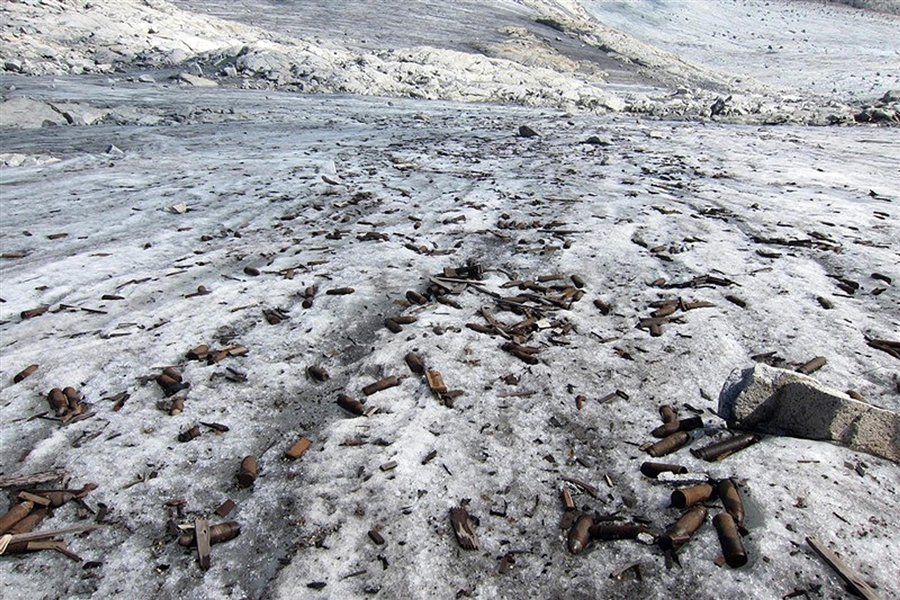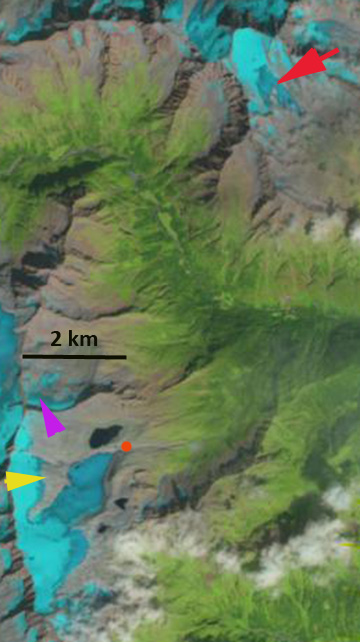September 26, 2012
Lobbia Glacier Retreat, Italy and World War I relic exposure
Posted by Mauri Pelto
The summer of 2012 was a warm one in the Italian Alps. This has led to large losses in glacier volume and exceptional surface melting. One example of this has been the exposure via melting of a considerable amount of World War I relics. One location noted has been the Ago Di Nardis Glacier in the Trentino Mountains, where artillery ammunition is observed Image from Maffei Glauco / Trentino Italian / EPA. In this post we use Landsat imagery from 1999, 2011 and 2012 to examine the retreat of Lobbia Glacier with a small note on the retraction of Ago Di Nardis Glacier. The Lobbia Glacier is adjacent to the Mandrone Glacier that has been examined in detail by the Università di Brescia, Italy (Ranzi et al, 2010), which lost over a meter of ice thickness on average from 1999-2006. The Lobbia Glacier retreat from 1999-2010 has been observed by the Italian Glaciological Survey and found to have retreated 140 meters from 1999-2005, and 45 m from 2006-2009. In the Landsat images the red arrow indicates the retraction in glacier width of Ago Di Nardis Glacier at the 3000 meter level. The Orange dot indicates the 1999 terminus location of Lobbia Glacier. The yellow arrow indicates the expansion of a bare rock area that had been surrounded by ice in 1999 on Lobbia Glacier. The purple arrow indicates the separation of horseshoe shape glacier adjacent to Lobbia Glacier.
In this post we use Landsat imagery from 1999, 2011 and 2012 to examine the retreat of Lobbia Glacier with a small note on the retraction of Ago Di Nardis Glacier. The Lobbia Glacier is adjacent to the Mandrone Glacier that has been examined in detail by the Università di Brescia, Italy (Ranzi et al, 2010), which lost over a meter of ice thickness on average from 1999-2006. The Lobbia Glacier retreat from 1999-2010 has been observed by the Italian Glaciological Survey and found to have retreated 140 meters from 1999-2005, and 45 m from 2006-2009. In the Landsat images the red arrow indicates the retraction in glacier width of Ago Di Nardis Glacier at the 3000 meter level. The Orange dot indicates the 1999 terminus location of Lobbia Glacier. The yellow arrow indicates the expansion of a bare rock area that had been surrounded by ice in 1999 on Lobbia Glacier. The purple arrow indicates the separation of horseshoe shape glacier adjacent to Lobbia Glacier.

 . The glacier has a low slope and few crevasses. The combination indicates low velocity and even stagnant conditions. The slopes on the west side of the glacier, yellow arrow are not retaining snowcover and no longer feed the glacier tongue. The lack of a consistent and persistent snowcover indicates a glacier that cannot survive (Pelto, 2010), image from TecTask. The current glacier health parallels that of Dosde Glacierand Presena Glacier
. The glacier has a low slope and few crevasses. The combination indicates low velocity and even stagnant conditions. The slopes on the west side of the glacier, yellow arrow are not retaining snowcover and no longer feed the glacier tongue. The lack of a consistent and persistent snowcover indicates a glacier that cannot survive (Pelto, 2010), image from TecTask. The current glacier health parallels that of Dosde Glacierand Presena Glacier


 Dean of Academic Affairs at Nichols College and Professor of Environmental Science at Nichols College in Massachusetts since 1989. Glaciologist directing the North Cascade Glacier Climate Project since 1984. This project monitors the mass balance and behavior of more glaciers than any other in North America.
Dean of Academic Affairs at Nichols College and Professor of Environmental Science at Nichols College in Massachusetts since 1989. Glaciologist directing the North Cascade Glacier Climate Project since 1984. This project monitors the mass balance and behavior of more glaciers than any other in North America.